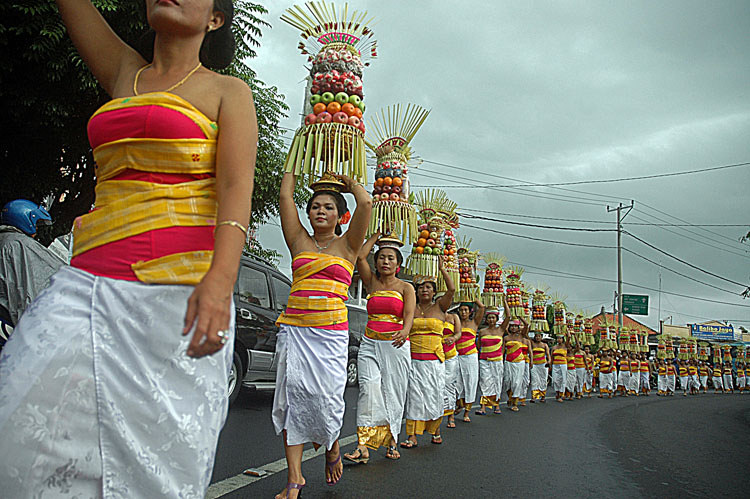The Mepeed ceremony, a significant part of Balinese Hindu culture, stands out as a captivating ritual that continues to draw attention for its beauty, meaning, and deep cultural roots. Derived from the word peed, meaning "to walk in line," Mepeed involves participants, primarily women, walking in a graceful procession while balancing offerings, known as Gebogan, on their heads. This ritual is more than just a visual spectacle—it is an expression of devotion, gratitude, and harmony with the divine.
Walk In Line and Offerings: The Unique Tradition of Mepeed

The Essence
Held every 210 days, Mepeed ceremonies are usually part of the Piodalan—the temple anniversary celebration. While every temple in Bali celebrates Piodalan at different times, the core essence of Mepeed remains consistent across the island. Participants bring offerings, which are tall, intricately arranged towers made up of fruits, flowers, cakes, and ornaments crafted from coconut leaves. These offerings, balanced on trays called Dulang, are symbolic gifts to the gods, reflecting the community's gratitude for blessings received.
In Sukawati, Gianyar Regency, Mepeed takes on a slightly different form compared to other parts of Bali. Here, the tradition involves not just women but men, children, and elders as well, making it a more inclusive ceremony. Interestingly, the participants in Sukawati do not carry Gebogan on their heads, but they still walk in long, orderly lines, dressed in traditional Balinese attire. The spectacle unfolds over four days, with each day drawing hundreds of participants, creating a scene of unity and devotion.

Cultural and Spiritual Remark
The Mepeed ceremony is deeply rooted in the sacred values of Balinese Hinduism. In Sukawati, the ceremony holds particular importance during the Pujawali, a bi-annual celebration marking the birthday of a temple, specifically the Dalem Gede Sukawati Temple. Mepeed is seen as an act of reverence to Ida Sang Hyang Widhi Wasa, the supreme god, and is carried out with the utmost devotion. One of the unique aspects of the Sukawati Mepeed is the goal of collecting tirta or holy water from the Taman Beji Temple. This water is used throughout the temple’s Pujawali ceremony, signifying purity and divine blessing.
The Beauty of the Procession
The visual appeal of Mepeed is one of the reasons it has captured the fascination of locals and visitors alike. The women, dressed in pristine white kebaya and traditional sarongs, walk gracefully in line, creating a scene of elegance and discipline. In some villages, participants dress in matching traditional outfits, and their synchronized movement adds a ceremonial rhythm to the event. The procession is often accompanied by the sounds of gamelan, traditional Balinese music, enhancing the spiritual ambiance.

For tourists, witnessing a Mepeed procession is a memorable experience. The sight of hundreds of villagers, young and old, walking together, each carrying offerings, provides a glimpse into the island’s rich cultural heritage. Photographers often flock to these events to capture the beauty of the participants, the towering Gebogan, and the intricate details of Balinese ceremonial attire.
Tradition That Walks the Test of Time
Mepeed is more than just a religious ritual; it is a living tradition passed down from generation to generation. It continues to serve as a reminder of the importance of community, faith, and gratitude in Balinese culture. Despite the island’s growing modernity and its influx of visitors, Mepeed remains a strong and unifying cultural practice. Sukawati, in particular, is known for its grand Mepeed processions, which can stretch for half a kilometer, showcasing the village’s commitment to preserving this sacred tradition.

Mepeed ceremony is a Balinese cultural event that offers a magnificent sight It is a celebration of life, spirituality, and the close bond between the Balinese people and their gods—a tradition that continues to captivate and inspire.




 Billy Bagus
Billy Bagus
 Sep 20, 2024
Sep 20, 2024






